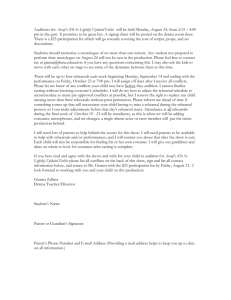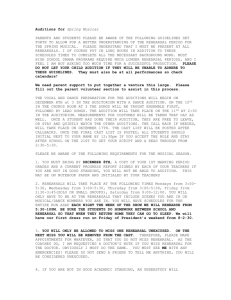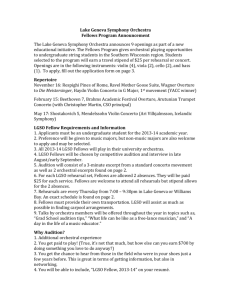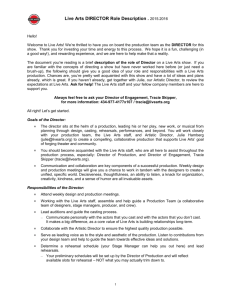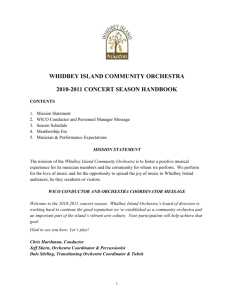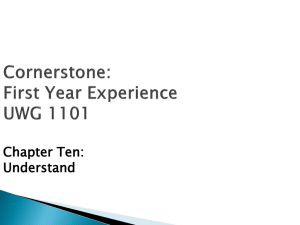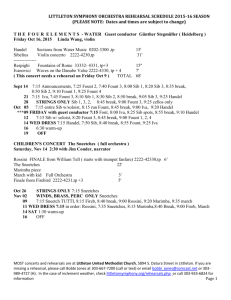PREPARING FOR REHEARSALS
advertisement
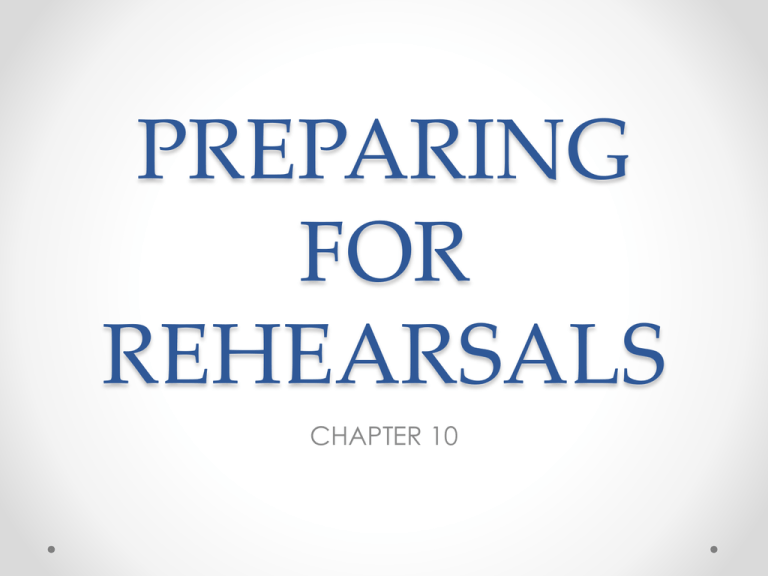
PREPARING FOR REHEARSALS CHAPTER 10 Rehearsals should be ‘fun’ oWell-organized not painful oEfficient not draining oProductive not a waste of time oJoyful not emotional Have a clear plan • You need to free the director and actors to concentrate on bringing the play to life • Free and unstructured rehearsals can lead to interesting results BUT • Structure enables the creative process by freeing the brain and heart Director’s checklist Preparing for rehearsal Organize the schedule (integrating actor conflicts) Make rehearsal plans Prepare a DPN (Director’s Production Notebook) Organize the rehearsal props Define the role and responsibilities of the PSM Develop a sign-in system, if needed Clearly communicate expectations to actors Set rehearsal rules Compile a contact list Display groundplans and elevations Create a safe environment Request that the actors prepare for each rehearsal and set goals Rehearsal Schedules Rehearsal Schedules Equity Calls • • • • Actors are on call for all rehearsals They are required to attend whenever called Typical work week is TU-SAT from 10 a.m. to 6 p.m. During Techs and Dresses, Equity rules allow for later calls o EIGHT OUT OF TEN. A schedule wherein actors can be scheduled for up to eight hours in a ten hour day. o TEN OUT OF TWELVE. A standard call for tech and dress rehearsal periods. • BREAKS o Equity requires five-minute breaks every hour or ten minutes if you work an hour and a half…PSM monitors these times carefully REHEARSAL RULES 1. 2. 3. 4. 5. 6. 7. 8. 9. 10. 11. 12. 13. 14. 15. Ten minutes early is on time. Call PSM if you are going to be late. Warm up on your own Be prepared No complaining No cellphones Breaks on the hour or hour and a half No “directing” other actors Problems? Speak up! Finish eating before, after or during breaks Come to rehearsal “high” on art, nothing else Come to rehearsal with goals and plans Bring something to read when not onstage If you need help, ask for it Have fun, don’t take it too seriously College & community theatre • Students and working people have thousands of things going on in their lives • Even when the director insists on no conflicts, they are an inevitability • As such, it is better to cast a good actor with a few conflicts than a mediocre one with none—but not always • Once you cast, use the audition form to help guide you in planning your rehearsal schedule • Keep the list of conflicts at hand as you schedule, make sure the PSM has a copy Creating a schedule • Break the script into french scenes/rehearsal units • For musicals, add songs and dance numbers to the breakdowns • Make a list of all scenes everyone is involved in • Note how much time is needed for each “unit” • Consider carefully the scheduling of first runs and designer/crew watches • Note dates for techs, dresses and performances Schedule the ‘landmarks’ PLAY • First day • Table readings • Blocking rehearsals • Off-book • Runthroughs • Crew watch • Final runthrough • Spacing rehearsals • Technicals • Final Dress • Opening Night MUSICAL • First day • Music rehearsals • Dance/staging rehearsals • Off-book • Runthroughs and brushups • Crew watch • Final runthrough • Spacing rehearsals • Technicals • Final Dress • Opening Night First Meeting Designer presentations and readthrough Already scheduled rehearsals Add your crew watches, techs, dresses, performances into your grid… First runthrough This should be between the halfway point and ¾ point of the rehearsal process before the Techs Table reading How much time you need depends upon what your goals are Blocking rehearsals • Schedule scene by scene • Try to schedule actors back to back • Breakdown each rehearsal • Double-check conflicts • Be respectful of everyone’s time For a musical… • Music rehearsals – non-musicians will need more time • Read and sing-through should be added to the schedule • Staging and dance rehearsals will often need to be scheduled out of sequence • Music and dance reviews will always be needed • Full runs are trickier since so much more in involved Review the schedule • Check and double-check before publishing… Prepare the rehearsal room Rehearsal props/furniture Water and restrooms Director’s table/chairs Prop table Rack for rehearsal clothes Chairs for actors and staff Ground plan Set renderings Costume renderings Final Thoughts The first rehearsals set the tone for the entire process Stumble-throughs • You need to review as often as you can
